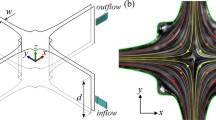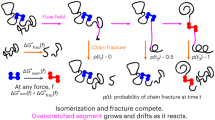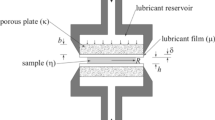Summary
Flow birefringence measurements have been obtained on three molecular weight samples (2−8 × 106 M W ,M W /M N = 1.14−1.3) of polystyrene in dilute solution (50–100 ppm) in a viscous polychorinated biphenyl solvent. The flows were generated using a four roll mill which could simulate a wide range of two dimensional flows in which the flow type (i.e. the ratio of the rate of rotation to the rate of strain) could be varied independently of the velocity gradient. The normalized birefringence, corrected for concentration, (Δn/nc), was observed to approach a saturation value at high velocity gradients in purely extensional flow. This saturation value was independent of both the molecular weight and the concentrationc, in agreement with theory. In addition, the magnitude of the saturation value is consistent with nearly fully extended chains and suggests extensions in the range of 20–50 times the rest state size. The data for the birefringence over a wide range of flows was found to be well correlated against the eigenvalue of the velocity gradient tensor in agreement with the results of the “strong/weak” flow theories ofTanner (1976) andOlbricht et al. (1980).
The experiments are compared with a simple dumbbell model which incorporates the effects of a nonlinear spring variable hydrodynamic friction, and internal viscosity. It is shown that this simple model can simulate the experimental results surprisingly well if the effects of molecular weight distribution and finite transit times in the flow device are taken into account.
Zusammenfassung
Es werden Doppelbrechungsmessungen an verdünnten Lösungen (50–100 ppm) von drei Polystyrolproben mit verschiedenem Molgewicht (M W = 2−8 ⋅ 106,M W /M N = 1,14−1,3) in einem polychlorierten Diphenyl-Lösungsmittel (Pyralene 4000) durchgeführt. Die Strömung wird in einer Vier-Walzen-Apparatur erzeugt, die zweidimensionale Strömungen in einem weiten Typenbereich (d. h. mit verschiedenen Verhältnissen von Rotations- zu Deformationsgeschwindigkeit) unabhängig vom Geschwindigkeitsgradienten herzustellen gestattet. Die bezüglich der Konzentration korrigierte normierte Doppelbrechung (Δn/nc) strebt bei reiner Dehnströmung mit hohem Geschwindigkeitsgradienten gegen einen Sättigungswert. Dieser ist in Übereinstimmung mit der Theorie sowohl vom Molgewicht als auch von der Konzentrationc unabhängig. Weiterhin entspricht die Größe dieses Sättigungswerts der Annahme nahezu vollständig gestreckter Ketten mit Ausdehnungen vom 20–50fachen der Ausdehnung im Ruhezustand. Die Doppelbrechungswerte sind in einem weiten Strömungsbereich gut mit dem Eigenwert des Tensors des Geschwindigkeitsgradienten korreliert, was mit den Ergebnissen der Theorien „starker“ und „schwacher Strömungen“ vonTanner (1976), sowieOlbricht und Mitarbeitern (1980) übereinstimmt.
Die Experimente werden mit den Voraussagen der Theorie des einfachen Hantelmodells verglichen, allerdings unter Einschluß eines nichtlinearen Federgesetzes, einer variablen hydrodynamischen Reibung und einer „inneren Viskosität“. Man findet, daß dieses einfache Modell die experimentellen Ergebnisse überraschend genau wiederzugeben vermag, wenn die Einflüsse der Molgewichtsverteilung sowie einer endlichen Einstellzeit in der Strömungsanordnung mitberücksichtigt werden.
Similar content being viewed by others
References
Batchelor, G. K. J. Fluid. Mech.44, 479 (1970).
Billmeyer, F. Textbook of Polymer Science, Interscience Publ. (New York 1962).
Bird, R. B., O. Hassager, R. C. Armstrong, C. F. Curtiss, Dynamics of Polymeric Liquids, Volume II: Kinetic Theory, Wiley (1977).
Cerf, R. J. Chim. Phys.66, 479 (1969).
Cox, R. G. J. Fluid. Mech.44, 791 (1970).
Crowley, P. G., F. C. Frank, M. R. Mackely, R. G. Stephenson J. Polym. Sci., Polym. Phys. Ed.14, 1111 (1976).
de Gennes, P. G. J. Chem. Phys.60, 5030 (1974).
de Gennes, P. G. J. Chem. Phys.66, 5825 (1977).
Dreher, K. D., W. B. Gogarty J. Rheol.23, 208 (1979).
Fuller, G. G., L. G. Leal, Flow Birefringence of Concentrated Polymer Solutions in Two Dimensional Flows, to appear J. Polym. Sci. (1980).
Fuller, G. G., L. G. Leal, The Effects of Conformation Dependent Friction and Internal Viscosity on the Dynamics of the Dumbbell Model for a Dilute Polymer Solution, to appear J. non-Newt. Fluid Mech. (1980).
Fuller, G. G., J. M. Rallison, R. L. Schmidt, L. G. Leal J. Fluid Mech.100, 555 (1980).
Hinch, E. J., Proc. Symp. Polym. Lubrification, Brest (1974).
Hinch, E. J. Phys. Fluids20, 522 (1977).
Kuhn, W., H. Kuhn Helv. Chim. Acta28, 1533 (1945).
Leal, L. G., G. G. Fuller, W. L. Olbricht, Studies of the Flow-Induced Stretching of a Macromolecule in a Dilute Solution, to appear, Prog. in Astronautics and Aeronautics; also presented at the Viscous Drag Reduction Symposium, Dallas, Texas, Nov. 7–8, 1979.
Olbricht, W. L., J. M. Rallison, L. G. Leal, A Criterion for Strong Flow Based on Microstructure Deformation, forthcoming publication.
Peterlin, A. J. Chem. Phys.21, 1272 (1963).
Peterlin, A. Polymer2, 257 (1961).
Peterlin, A. Ann. Rev. Fluid Mech.8, 35 (1976).
Philippoff, W. in:E. H. Lee (ed.), Proc. IV Intern. Congr. Rheol., Providence 1963, Vol. 2, p. 343, Interscience Publ. (New York 1965).
Phan-Thien, N., J. D. Atkinson, R. I. Tanner J. Non-Newtonian Fluid Mech.3, 309 (1978).
Polymer Handbook, Eds.Brandrup, J., E. H. Immergut, John Wiley and Sons Publ. (1965).
Pope, D. P., A. Keller Colloid and Polym. Sci.255, 633 (1977).
Pope, D. P., A. Keller Colloid and Polym. Sci.256, 751 (1978).
Rouse, P. E. Jr. J. Chem. Phys.21, 1272 (1953).
Sankur, V. D., Phd. Thesis, California Institute of Technology (1976).
Tanner, R. I. Trans. Soc. Rheol.19, 557 (1975).
Tanner, R. I. Amer. Inst. Chem. Engs. J.22, 910 (1976).
Warner, H. R. Ind. Eng. Chem. Fund.11, 375 (1972).
Zimm, B. H. J. Chem. Phys.24, 269 (1956).
Author information
Authors and Affiliations
Additional information
With 17 figures and 1 table
Rights and permissions
About this article
Cite this article
Fuller, G.G., Leal, L.G. Flow birefringence of dilute polymer solutions in two-dimensional flows. Rheol Acta 19, 580–600 (1980). https://doi.org/10.1007/BF01517512
Received:
Issue Date:
DOI: https://doi.org/10.1007/BF01517512




